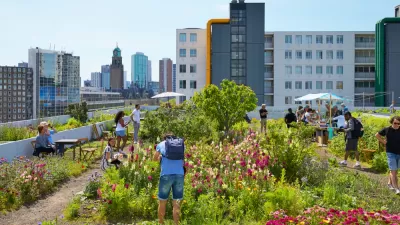White roofs have gained cachet as a solution to the urban heat island effect. But in places where there are more cold days than hot, a white roof that reflects warming sunlight might not make the best sense, according to this piece.
"By having information on the different roof choices, building owners can choose the roof that is best for their location and climate, and that best solution isn't always white.
The Cool Roof Rating Council admits to a "winter penalty" when cool roofs are installed in northern climates. An article in the April edition of Maintenance Solutions magazine that was penned by the CRRC states, "Heating costs may increase slightly for buildings located in cooler regions." CRRC's justification for increasing heating costs and greenhouse gasses was that days (sunlight hours) are longer in the summer than they are in the winter, thus more energy is consumed to cool a building than to heat it.
The article failed to mention spring and autumn. However, information gathered from the U.S. Department of Energy clearly demonstrates that heating is a much more significant factor in energy usage than cooling. For instance, Grand Rapids, Mich., has 7,153 heating degree days versus 508 cooling degree days per year, which means heating equipment runs approximately 14.3 hours for every one hour that cooling equipment runs."
"...To illustrate this point, I've chosen three major U.S. cities and provided analyses of energy and carbon footprint models, all generated using the DOE's cool-roof calculator, to help lend some clarification and hopefully dispel some growing cool-roof myths.
• Boston, Mass.: 5,841 HDD versus 646 CDD
• Grand Rapids, Mich.: 7,153 HDD versus 508 CDD
• Albuquerque, N.M.: 4,361 HDD versus 1,211 CDD
Due to the overwhelming amount of heating degree days and positive winter heat gain in these locations, in all instances, energy consumption and carbon emissions are fewer with a dark roof surface than with a reflective surface. This is true even as far south as Albuquerque. It is also important to note that increased insulation dramatically reduces energy consumption in every model."
FULL STORY: A White Roof Isn't Always the Right Roof

Planetizen Federal Action Tracker
A weekly monitor of how Trump’s orders and actions are impacting planners and planning in America.

Maui's Vacation Rental Debate Turns Ugly
Verbal attacks, misinformation campaigns and fistfights plague a high-stakes debate to convert thousands of vacation rentals into long-term housing.

San Francisco Suspends Traffic Calming Amidst Record Deaths
Citing “a challenging fiscal landscape,” the city will cease the program on the heels of 42 traffic deaths, including 24 pedestrians.

Defunct Pittsburgh Power Plant to Become Residential Tower
A decommissioned steam heat plant will be redeveloped into almost 100 affordable housing units.

Trump Prompts Restructuring of Transportation Research Board in “Unprecedented Overreach”
The TRB has eliminated more than half of its committees including those focused on climate, equity, and cities.

Amtrak Rolls Out New Orleans to Alabama “Mardi Gras” Train
The new service will operate morning and evening departures between Mobile and New Orleans.
Urban Design for Planners 1: Software Tools
This six-course series explores essential urban design concepts using open source software and equips planners with the tools they need to participate fully in the urban design process.
Planning for Universal Design
Learn the tools for implementing Universal Design in planning regulations.
Heyer Gruel & Associates PA
JM Goldson LLC
Custer County Colorado
City of Camden Redevelopment Agency
City of Astoria
Transportation Research & Education Center (TREC) at Portland State University
Jefferson Parish Government
Camden Redevelopment Agency
City of Claremont





























